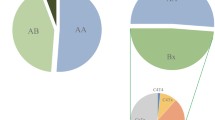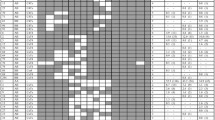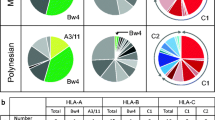Abstract
The extreme variability at the Killer cell Immunoglobulin-like Receptor (KIR) locus along with that of the genes encoding their ligands, HLA class I, appears to modulate risk for viral, autoimmune, and malignant diseases, and reproductive failure. Differences in KIR gene and haplotype frequencies across world populations may reflect some combination of ancestral genotypes, locale-specific selection pressures, and genetic drift. We genotyped unrelated healthy Parsis and Maharashtrian Hindus, neighboring peoples from Western India. These two populations showed remarkable similarity in KIR gene frequencies despite their distinct ethnic background and the fairly recent migration of Parsis to Western India from Persia around 900 A.D. One clear exception is KIR3DS1, which is found at a significantly higher frequency in the Parsis than in the Maharashtrians, previously characterized North Indians, and most other world populations. The high KIR3DS1 frequency of Parsis corresponds with a low frequency of its putative HLA-B ligand group, an inverse correlation that has been observed previously across other world populations. Thus, KIR3DS1 frequency in Parsis may be a remnant of their distinct ancestral Persian origin. KIR gene frequencies and profiles of the Parsis and Maharashtrians were more similar to one another than they were to North Indians, suggesting a potential effect of local environmental factors on KIR evolution and/or some degree of admixture between Parsis and populations from Western India. Overall, these data support other studies indicating the rapid evolution of the KIR locus and the apparent dependency of this evolution on the loci encoding HLA class I ligands.


Similar content being viewed by others
Abbreviations
- HLA:
-
human leukocyte antigen
- NK:
-
natural killer
- KIR:
-
killer immunoglobulin-like receptor
- LD:
-
linkage disequilibrium
References
Boyum A (1968) Separation of leukocytes from blood and bone marrow. Introduction. Scand J Clin Lab Invest Suppl 97:7
Carrington M, Norman RJ (2003) The KIR gene cluster. National library of medicine (US), National Centre for Biotechnology Information, Bethesda, MD
Carrington M, Martin MP (2006) The impact of variation at the KIR gene cluster on human disease. Curr Top Microbiol Immunol 298:225–257
Colucci F, Di Santo JP, Leibson PJ (2002) Natural killer cell activation in mice and men: different triggers for similar weapons? Nat Immunol 3:807–813
Cook MA, Moss PA, Briggs DC (2003) The distribution of 13 killer-cell immunoglobulin-like receptor loci in UK blood donors from three ethnic groups. Eur J Immunogenet 30:213–221
Denis L, Sivula J, Gourraud PA, Kerdudou N, Chout R, Ricard C, Moisan JP, Gagne K, Partanen J, Bignon JD (2005) Genetic diversity of KIR natural killer cell markers in populations from France, Guadeloupe, Finland, Senegal and Reunion. Tissue Antigens 66:267–276
Desai AS (2004) Addressing population concerns and community response. FEZANA J 17:31
Du Z, Gjertson DW, Reed EF, Rajalingam R (2007) Receptor–ligand analyses define minimal killer cell Ig-like receptor (KIR) in humans. Immunogenetics 59:1–15
Hao L, Nei M (2005) Rapid expansion of killer cell immunoglobulin-like receptor genes in primates and their coevolution with MHC Class I genes. Gene 347:149–159
Hsu KC, Liu XR, Selvakumar A, Mickelson E, O’Reilly RJ, Dupont B (2002) Killer Ig-like receptor haplotype analysis by gene content: evidence for genomic diversity with a minimum of six basic framework haplotypes, each with multiple subsets. J Immunol 169:5118–5129
Imanishi T, Azaka T, Kimura A et al (1991) Estimation of allele and haplotype frequencies for HLA and complement loci. In: Tsuji K, Aizawa M, Sasazuki T (eds.) Vol 1, HLA:1991 Proceedings of the Eleventh International Histocompatibility Workshop and Conference. Oxford
Jiang K, Zhu FM, Lv QF, Yan LX (2005) Distribution of killer cell immunoglobulin-like receptor genes in the Chinese Han population. Tissue Antigens 65:556–563
Khakoo SI, Carrington M (2006) KIR and disease: a model system or system of models? Immunol Rev 214:186–201
Khakoo SI, Rajalingam R, Shum BP, Weidenbach K, Flodin L, Muir DG, Canavez F, Cooper SL, Valiante NM, Lanier LL, Parham P (2000) Rapid evolution of NK cell receptor systems demonstrated by comparison of chimpanzees and humans. Immunity 12:687–698
Lanier LL (2005) NK cell recognition. Annual Review of Immunology 23:225–274
Mahfouz R, Rayes R, Mahfoud Z, Bazarbachi A, Zaatari G (2006) Distribution of killer cell immunoglobulin-like receptors genotypes in the Lebanese population. Tissue Antigens 68:66–71
Martin MP, Carrington M (2007) KIR Locus Polymorphisms: Genotyping and Disease Association Analysis. In: Ewbank J, Vivier E (eds) Methods in molecular biology: Innate immunity. Humana, Totowa, NJ, pp 49–64
Nanavutty P (1997) The Parsis. National Book Trust, New Delhi
Norman PJ, Stephens HA, Verity DH, Chandanayingyong D, Vaughan RW (2001) Distribution of natural killer cell immunoglobulin-like receptor sequences in three ethnic groups. Immunogenetics 52:195–205
Norman PJ, Carrington CV, Byng M, Maxwell LD, Curran MD, Stephens HA, Chandanayingyong D, Verity DH, Hameed K, Ramdath DD, Vaughan RW (2002) Natural killer cell immunoglobulin-like receptor (KIR) locus profiles in African and South Asian populations. Genes and Immun 3:86–95
Parham P (2005) MHC class I molecules and KIRs in human history, health and survival. Nat Rev Immunol 5:201–214
Qamar R, Ayub Q, Mohyuddin A, Helgason A, Mazhar K, Mansoor A, Zerjal T, Tyler-Smith C, Mehdi SQ (2002) Y-chromosomal DNA variation in Pakistan. Am J Hum Genet 70:1107–1124
Quintana-Murci L, Chaix R, Wells RS, Behar DM, Sayar H, Scozzari R, Rengo C, Al-Zahery N, Semino O, Santachiara-Benerecetti AS, Coppa A, Ayub Q, Mohyuddin A, Tyler-Smith C, Qasim Mehdi S, Torroni A, McElreavey K (2004) Where west meets east: the complex mtDNA landscape of the southwest and Central Asian corridor. Am J Hum Genet 74:827–845
Rajalingam R, Krausa P, Shilling HG, Stein JB, Balamurugan A, McGinnis MD, Cheng NW, Mehra NK, Parham P (2002) Distinctive KIR and HLA diversity in a panel of north Indian Hindus. Immunogenetics 53:1009–1019
Santin I, de Nanclares GP, Calvo B, Gaafar A, Castano L, Bilbao JR (2006) Killer cell immunoglobulin-like receptor (KIR) genes in the Basque population: association study of KIR gene contents with type 1 diabetes mellitus. Hum Immunol 67:118–124
Shilling HG, Guethlein LA, Cheng NW, Gardiner CM, Rodriguez R, Tyan D, Parham P (2002) Allelic polymorphism synergizes with variable gene content to individualize human KIR genotype. J Immunol 168:2307–2315
Single RM, Martin MP, Gao X, Meyer D, Yeager M, Kidd JR, Kidd KK, Carrington M (2007) Global diversity and evidence for coevolution of KIR and HLA. Nat Genet 39:1114–1119
Toneva M, Lepage V, Lafay G, Dulphy N, Busson M, Lester S, Vu-Trien A, Michaylova A, Naumova E, McCluskey J, Charron D (2001) Genomic diversity of natural killer cell receptor genes in three populations. Tissue Antigens 57:358–362
Uhrberg M, Valiante NM, Shum BP, Shilling HG, Lienert-Weidenbach K, Corliss B, Tyan D, Lanier LL, Parham P (1997) Human diversity in killer cell inhibitory receptor genes. Immunity 7:753–763
Velickovic M, Velickovic Z, Dunckley H (2006) Diversity of killer cell immunoglobulin-like receptor genes in Pacific Islands populations. Immunogenetics 58:523–532
Vilches C, Parham P (2002) KIR: diverse, rapidly evolving receptors of innate and adaptive immunity. Annu Rev Immunol 20:217–251
Wallace DM (1987) General methods for isolating and characterizing nucleic acids: Large- and small-scale phenol extractions. Methods Enzymol 152:33–44
Whang DH, Park H, Yoon JA, Park MH (2005) Haplotype analysis of killer cell immunoglobulin-like receptor genes in 77 Korean families. Hum Immunol 66:146–154
Wilson MJ, Torkar M, Haude A, Milne S, Jones T, Sheer D, Beck S, Trowsdale J (2000) Plasticity in the organization and sequences of human KIR/ILT gene families. Proc Natl Acad Sci U S A 97:4778–4783
Yawata M, Yawata N, McQueen KL, Cheng NW, Guethlein LA, Rajalingam R, Shilling HG, Parham P (2002) Predominance of group A KIR haplotypes in Japanese associated with diverse NK cell repertoires of KIR expression. Immunogenetics 54:543–550
Acknowledgements
The authors would like to thank Dr. K. A. Dinshaw, Director, Tata Memorial Centre, Mumbai, Dr. R. Sarin, Director, ACTREC, Navi Mumbai, Dr. B.B. Yeole, Director and Mrs. Lata Shirsat, Medical Social Worker of the Bombay Cancer Registry, Indian Cancer Society, Mumbai, India for their assistance in contacting and recruiting study subjects and Mrs. K. Sadhana, Statistician at Cancer Research Institute, ACTREC, Navi Mumbai, India for helpful discussions. We also wish to thank Dr. Ying Qi, NCI-Frederick for statistical support. This work was supported by a grant from the Lady Tata Memorial Trust. This project has been funded in whole or in part with federal funds from the National Cancer Institute, National Institutes of Health, under contract N01-CO-12400. The content of this publication does not necessarily reflect the views or policies of the Department of Health and Human Services, nor does mention of trade names, commercial products, or organizations imply endorsement by the U.S. Government. This Research was supported in part by the Intramural Research Program of the NIH, National Cancer Institute, Center for Cancer Research.
Author information
Authors and Affiliations
Corresponding authors
Rights and permissions
About this article
Cite this article
Kulkarni, S., Single, R.M., Martin, M.P. et al. Comparison of the rapidly evolving KIR locus in Parsis and natives of India. Immunogenetics 60, 121–129 (2008). https://doi.org/10.1007/s00251-008-0279-1
Received:
Accepted:
Published:
Issue Date:
DOI: https://doi.org/10.1007/s00251-008-0279-1




